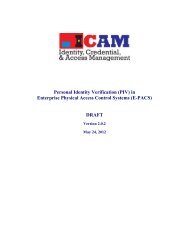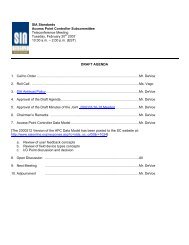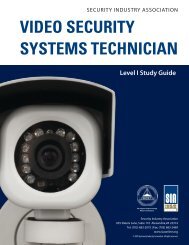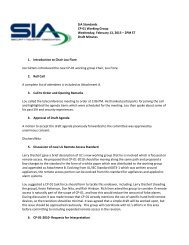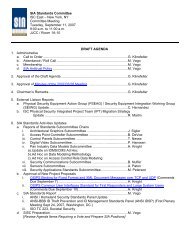Minutes - Security Industry Association
Minutes - Security Industry Association
Minutes - Security Industry Association
You also want an ePaper? Increase the reach of your titles
YUMPU automatically turns print PDFs into web optimized ePapers that Google loves.
SIA Standards<br />
Kickoff Meeting – Intrusion Subcommittee<br />
Wednesday, October 5, 2011 – 3PM ET<br />
Draft <strong>Minutes</strong><br />
1. Call to Order and Opening Remarks<br />
The meeting was called to order at 3:02 PM. Mr. Nesse thanked participants for joining<br />
the call and requested we do a roll call before proceeding to Mr. Van Till’s opening<br />
remarks.<br />
Mr. Van Till addressed the group and gave a description of the landscape that we are<br />
working in. He talked about SIA’s harmonization efforts and how SIA plans to<br />
collaborate with other standards/specification bodies and the new Roadmap. He<br />
stressed participation from business leaders in getting their engineers involved, and<br />
using the working group as a forum to drive work products along.<br />
2. Roll Call<br />
A complete list of attendees is included as Attachment A.<br />
3. Approval of Draft Agenda<br />
Mr. Nesse asked for a motion to approve the draft agenda as structured<br />
L. Dischert/K. Harris<br />
Motion Passes with Unanimous consent.<br />
4. Committee Overview<br />
a. Recent Standards Restructuring – Mr. Nesse explained that this subcommittee<br />
was the Field Devices Interface Standards and oversaw activities related to<br />
direct communication standards, control panel standards including CP-01 and<br />
also activities such as the security industry glossary. The new subcommittee<br />
focuses on much of the same work, however the Glossary has been moved to<br />
the Framework subcommittee.<br />
b. DC-09 Review Project – this standard is coming up on review and there have<br />
been a few proposals and contributions presented.<br />
c. Other Standards Reviews – There are a number of standards coming up for<br />
revision that the group must decide on how we are to proceed.
d. DSC Fibro Protocol Publication – There has been talk about SIA Standards<br />
publishing and distributing the DSC Fibro protocol, this will be discussed<br />
e. CP-01 Status – A review of the CP-01 happenings since it’s release in 2010<br />
f. Glossary Project Status – Glossary update<br />
5. DC-09 Project Review<br />
a. Review Project Proposal (Attachment B)<br />
Mr. Nesse went over the highlights of the project proposal. The group had no<br />
questions about the proposal. The proposal will be forwarded to the SIA<br />
Standards Committee on November 2 nd for approval. Mr Nesse asked for a<br />
motion to forward the project proposal to the SIA Standards Committee for<br />
approval.<br />
R. Hinkson/L. Dischert<br />
Motion Passes with Unanimous Consent<br />
b. Review Contribution from Amstein & Walthert (Attachment C)<br />
Mr. Nesse summarized the contribution to the standard from Amstein &<br />
Walthert: as follows, and gave his own thoughts on whether the contribution<br />
would be beneficial to be included.<br />
2.1b Additional Parameters<br />
• MAC - matches existing, OK<br />
• alarm text: OK<br />
• site name: OK<br />
• building name: OK<br />
• location: OK<br />
• room: OK<br />
• trigger: OK, may conflict with or duplicate the data message, but seems a<br />
useful extension<br />
• X, Y, Z: OK<br />
• an extension of ASCII to allow accented characters should be considered<br />
(how is this extension defined?)
Is the intent to send multiple messages to send more information to describe an<br />
event, or to define a delimiter? It seems multiple messages are more likely to<br />
be acceptable due to limitations on the overall message length.<br />
1.2 Sequential Retransmission<br />
The proposed sequence appears reasonable and effective. Perhaps this can be<br />
added as annex material.<br />
2.2 Examples<br />
The UML sequence diagrams appear effective and would be a good addition to<br />
the document.<br />
1.3 Monitoring of the Connection<br />
This information seems to go beyond the scope of the protocol standard. If<br />
included at all, it would be annex material.<br />
1.3a Transmission Parameter<br />
This too is beyond the protocol spec, but seems to be useful annex material<br />
once the details are defined.<br />
1.3b Redundancy<br />
This information seems to go beyond the scope of the protocol standard. If<br />
included at all, it would be annex material.<br />
1.4, 2.4 Messages for Reverse Commands<br />
It may not be feasible to document these requirements, and polling intervals are<br />
generally too long to allow reasonable response times for commands. Also, it<br />
generally doesn't make sense to administer this through the receivers- in most<br />
systems where it started in the receivers it has been moved to a separate PC<br />
application.<br />
1 NAK<br />
The transmitter should process the NAK message to set its internal time<br />
reference to that of the receiver so that the next message can be accepted. This<br />
seems clear in the document: "in order to allow the transmitter to adjust its<br />
internal clock". Generally, the transmitter would maintain a time base<br />
independently of the user-viewable time base, as even with mandated GMT<br />
time usage, it is common that the time used by the central station and the time<br />
used by the user are not the same.
2 Error Handling<br />
Handling for a wrong CRC (checksum) or time stamp are specifically covered in<br />
the existing document. Incorrect decryption would cause a checksum failure.<br />
The DUH message is intended as a catchall for messages that are<br />
"unprocessable" for other reasons, so it would be difficult to further define this.<br />
1 Check Criterion<br />
The existing extended data definition to carry the MAC address seems sufficient.<br />
Should this field become mandatory for some implementations?<br />
2 Encrypted Size<br />
Less effort is being expended in newer designs to reduce data size, so that the<br />
data encoding is more robust and more easily debugged.<br />
3 Checklist of Main Requirements<br />
This would be an excellent annex.<br />
4 Token Table<br />
It's generally avoided to duplicate information from one standard in another<br />
document to keep the two documents from coming into later conflict. But<br />
repeating the reference table as an annex would be reasonable.<br />
1 Data Encryption<br />
The document references FIPS 197 for AES encryption. Use of encryption is<br />
certainly desirable, but this standard does not need to mandate its use.<br />
2 Hash<br />
The encryption provides enough of a signature to satisfy most message<br />
authentication requirements, but a scheme to include a specific signature could<br />
be designed and included in the standard.<br />
3 2009 Errata<br />
This information needs to be incorporated in the published document.<br />
4 Formatting<br />
The document could be reformatted to improve clarity.<br />
5 prEN 50136-1-7 Interoperability<br />
Considerable analysis would be required to comment on the feasibility of<br />
defining a translation from one protocol to the next.
c. Next steps<br />
Schedule a meeting of this committee with the primary focus of tackling DC-09.<br />
This meeting will be discussed at the end of the call.<br />
6. Other Standards Reviews (Brief Discussion & Prioritize)<br />
a. DC-03 -- Digital Communications Standard<br />
i. There were no thoughts on this standard, Mr. Nesse suggested a<br />
superficial update.<br />
b. DC-04 – SIA 2000 Protocol<br />
i. Mr. Hinkson said that he has seen some receiver implementations, but<br />
isn’t sure that it got any traction, one route would be to move that this<br />
standard be withdrawn.<br />
c. DC-05 – Ademco ® Contact ID Protocol<br />
i. SIA Distribution of new definitions<br />
ii. Publish updated event table<br />
iii. Rich Hinkson from Ademco said that he can send the documents to SIA<br />
and have them distributed with the standard.<br />
d. DC-07 – Receiver to Computer Interface Protocol (Type 2)<br />
i. Normal, superficial update may be in order<br />
e. AV-01 -- Audio Verification Standard Protocol for Audio Verification and Two-<br />
Way Voice - Monitoring Service Command Set<br />
i. Reaffirm possible without an update<br />
f. MSD-01 – Monitoring Practices Standard<br />
i. ANSI Standard that hasn’t been updated since 2000<br />
ii. Has been a candidate for administratively withdrawn<br />
iii. PINS in place, we can reaffirm or review within the next few<br />
g. PIR-01 -- Passive Infrared Motion Detector Standard Revisions<br />
i. Mr. Hinkson mentioned that PIR-01 for QC testing as a reference<br />
ii. Mr. Reimer from Bosch volunteered to look into the usage within his<br />
company.
7. DSC Fibro Protocol<br />
a. Status Update<br />
This standard was supposed to be released similar to the DC-05 standard, at this<br />
point we are waiting for DSC to send an email back to begin the process. Kevin<br />
Harris from DSC volunteered to contact the correct people internally for<br />
approval.<br />
b. Application Guide<br />
This could cover some specialized use cases and informal applications that can<br />
be published after the specification is green-lit.<br />
8. CP-01<br />
a. Current Status<br />
The last meeting clarified that manufacturers can label their product as<br />
compliant to older versions of CP-01 as long as they make clear to what version<br />
the product is compliant to.<br />
b. Call for Volunteers to Lead CP-01 Working Group<br />
SIA would like to have someone close to the effort take over leadership of the<br />
working group. A call for volunteers will be released in the upcoming weeks.<br />
9. Glossary project<br />
a. Current Status<br />
160+ definitions are available and are housed on www.securityglossary.wikispaces.net<br />
b. Call for Volunteers to Lead Working Group<br />
A call for volunteers will also be distributed to lead this group<br />
10. Adjournment & Next Steps<br />
Mr. Nesse proposed a meeting of the committee after ISC Solutions that will consider 2<br />
topics. Disposition of renewed/withdrawn standards and also an in-depth DC-09<br />
conversation. In order to make it more accessible for participants from Europe the<br />
proposed time would be 8AM PT.
Mr. Nesse entertained a motion to adjourn at 4:05PM<br />
Dischert/Hinkson
Attachment A – List of Participants<br />
Organization<br />
ADT<br />
AES<br />
AES<br />
Amstein & Walthert<br />
Bosch<br />
Bosch<br />
Bosch<br />
Brivo<br />
Honeywell<br />
Honeywell<br />
North Lattitude<br />
Tyco<br />
UL<br />
UTC<br />
Participant<br />
Larry Dischert<br />
Bill Goretkin<br />
Jim Lynch<br />
Stephane Jacquet<br />
Micheal Reimer<br />
Bryan Matthewson<br />
Denis Caler<br />
Steve Van Till<br />
Rich Hinkson<br />
Linda Ortezi<br />
Ted Nesse<br />
Kevin Harris<br />
Bryon Monte<br />
Kevin Flanders



